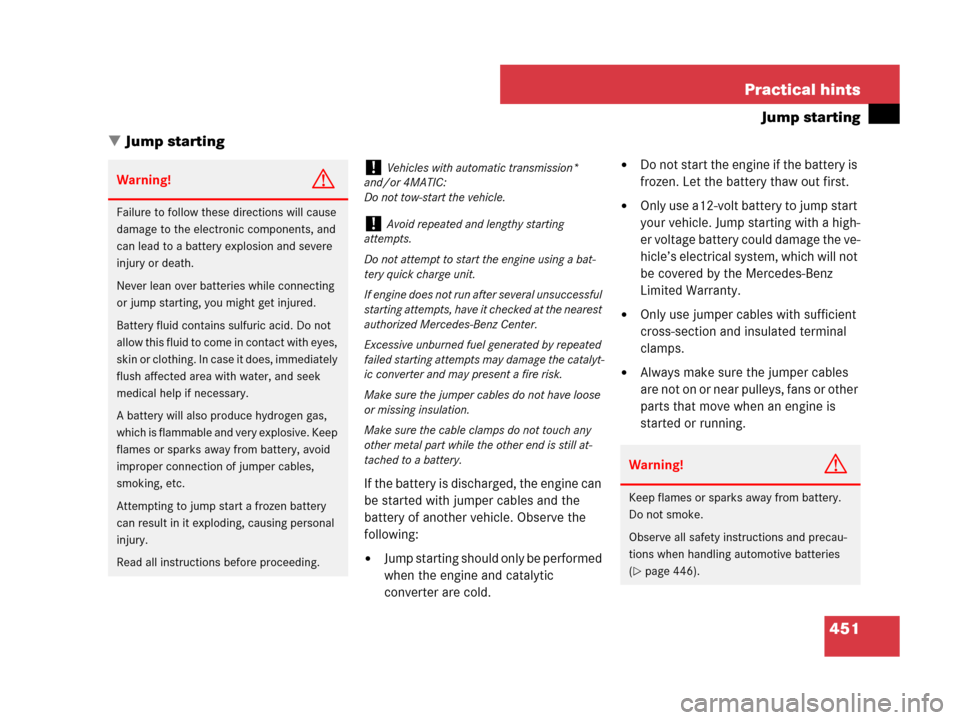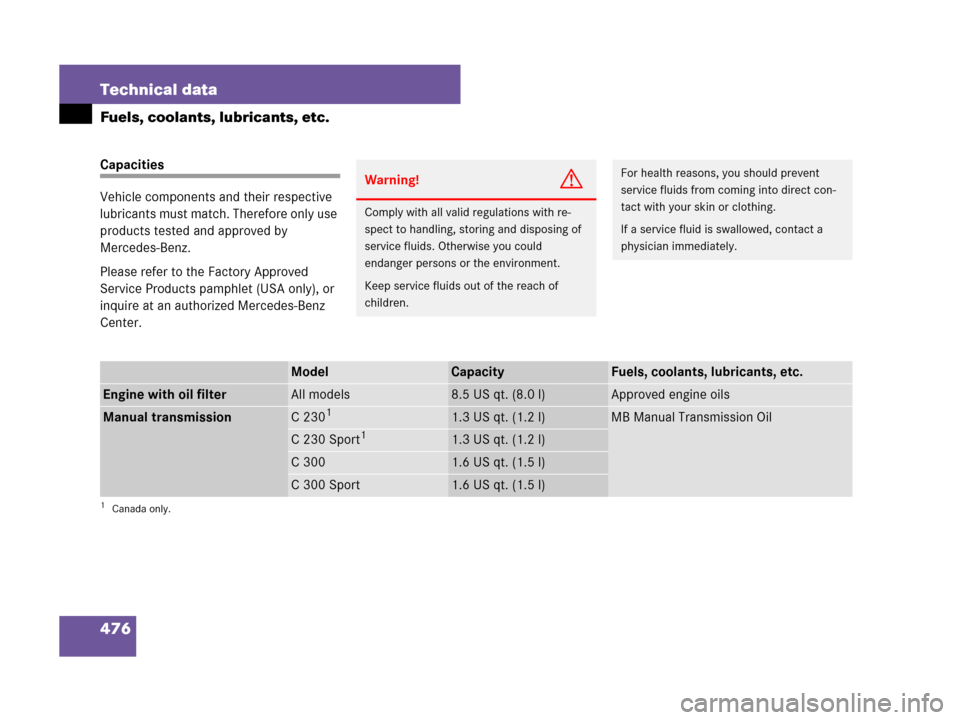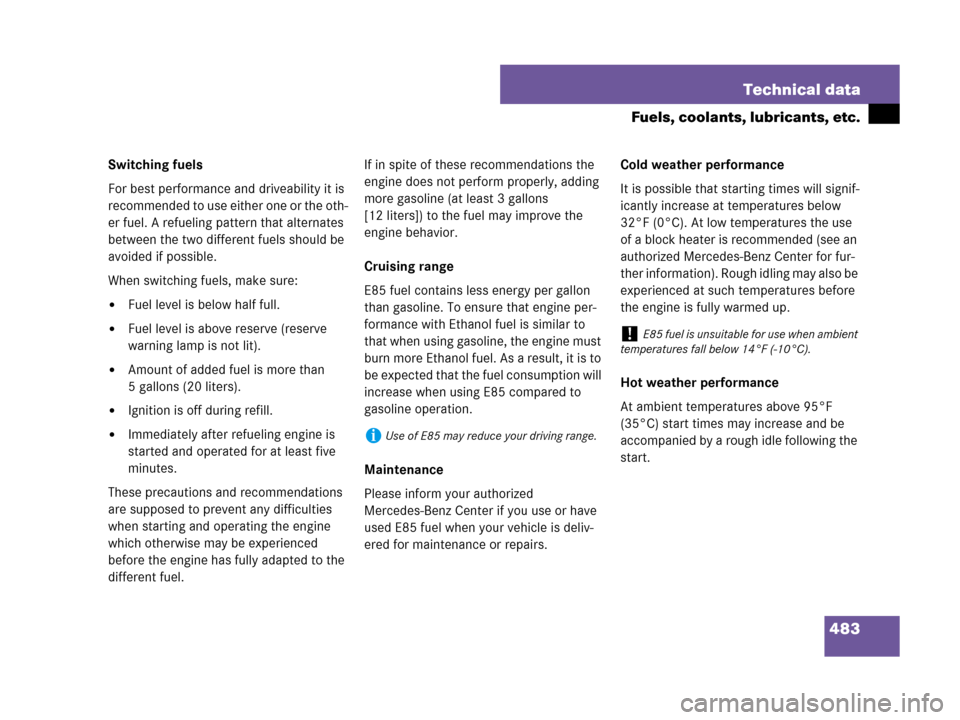Page 452 of 509

451 Practical hints
Jump starting
�Jump starting
If the battery is discharged, the engine can
be started with jumper cables and the
battery of another vehicle. Observe the
following:
�Jump starting should only be performed
when the engine and catalytic
converter are cold.
�Do not start the engine if the battery is
frozen. Let the battery thaw out first.
�Only use a12-volt battery to jump start
your vehicle. Jump starting with a high-
er voltage battery could damage the ve-
hicle’s electrical system, which will not
be covered by the Mercedes-Benz
Limited Warranty.
�Only use jumper cables with sufficient
cross-section and insulated terminal
clamps.
�Always make sure the jumper cables
are not on or near pulleys, fans or other
parts that move when an engine is
started or running.
Warning!G
Failure to follow these directions will cause
damage to the electronic components, and
can lead to a battery explosion and severe
injury or death.
Never lean over batteries while connecting
or jump starting, you might get injured.
Battery fluid contains sulfuric acid. Do not
allow this fluid to come in contact with eyes,
skin or clothing. In case it does, immediately
flush affected area with water, and seek
medical help if necessary.
A battery will also produce hydrogen gas,
which is flammable and very explosive. Keep
flames or sparks away from battery, avoid
improper connection of jumper cables,
smoking, etc.
Attempting to jump start a frozen battery
can result in it exploding, causing personal
injury.
Read all instructions before proceeding.
!Vehicles with automatic transmission*
and/or 4MATIC:
Do not tow-start the vehicle.
!Avoid repeated and lengthy starting
attempts.
Do not attempt to start the engine using a bat-
tery quick charge unit.
If engine does not run after several unsuccessful
starting attempts, have it checked at the nearest
authorized Mercedes-Benz Center.
Excessive unburned fuel generated by repeated
failed starting attempts may damage the catalyt-
ic converter and may present a fire risk.
Make sure the jumper cables do not have loose
or missing insulation.
Make sure the cable clamps do not touch any
other metal part while the other end is still at-
tached to a battery.
Warning!G
Keep flames or sparks away from battery.
Do not smoke.
Observe all safety instructions and precau-
tions when handling automotive batteries
(
�page 446).
Page 477 of 509

476 Technical data
Fuels, coolants, lubricants, etc.
Capacities
Vehicle components and their respective
lubricants must match. Therefore only use
products tested and approved by
Mercedes-Benz.
Please refer to the Factory Approved
Service Products pamphlet (USA only), or
inquire at an authorized Mercedes-Benz
Center.
Warning!G
Comply with all valid regulations with re-
spect to handling, storing and disposing of
service fluids. Otherwise you could
endanger persons or the environment.
Keep service fluids out of the reach of
children.
For health reasons, you should prevent
service fluids from coming into direct con-
tact with your skin or clothing.
If a service fluid is swallowed, contact a
physician immediately.
ModelCapacityFuels, coolants, lubricants, etc.
Engine with oil filterAll models8.5 US qt. (8.0 l)Approved engine oils
Manual transmissionC 2301
1Canada only.
1.3 US qt. (1.2 l)MB Manual Transmission Oil
C 230 Sport11.3 US qt. (1.2 l)
C 3001.6 US qt. (1.5 l)
C 300 Sport1.6 US qt. (1.5 l)
Page 484 of 509

483 Technical data
Fuels, coolants, lubricants, etc.
Switching fuels
For best performance and driveability it is
recommended to use either one or the oth-
er fuel. A refueling pattern that alternates
between the two different fuels should be
avoided if possible.
When switching fuels, make sure:
�Fuel level is below half full.
�Fuel level is above reserve (reserve
warning lamp is not lit).
�Amount of added fuel is more than
5 gallons (20 liters).
�Ignition is off during refill.
�Immediately after refueling engine is
started and operated for at least five
minutes.
These precautions and recommendations
are supposed to prevent any difficulties
when starting and operating the engine
which otherwise may be experienced
before the engine has fully adapted to the
different fuel.If in spite of these recommendations the
engine does not perform properly, adding
more gasoline (at least 3 gallons
[12 liters]) to the fuel may improve the
engine behavior.
Cruising range
E85 fuel contains less energy per gallon
than gasoline. To ensure that engine per-
formance with Ethanol fuel is similar to
that when using gasoline, the engine must
burn more Ethanol fuel. As a result, it is to
be expected that the fuel consumption will
increase when using E85 compared to
gasoline operation.
Maintenance
Please inform your authorized
Mercedes-Benz Center if you use or have
used E85 fuel when your vehicle is deliv-
ered for maintenance or repairs.Cold weather performance
It is possible that starting times will signif-
icantly increase at temperatures below
32°F (0°C). At low temperatures the use
of a block heater is recommended (see an
authorized Mercedes-Benz Center for fur-
ther information). Rough idling may also be
experienced at such temperatures before
the engine is fully warmed up.
Hot weather performance
At ambient temperatures above 95°F
(35°C) start times may increase and be
accompanied by a rough idle following the
start.iUse of E85 may reduce your driving range.
!E85 fuel is unsuitable for use when ambient
temperatures fall below 14°F (-10°C).